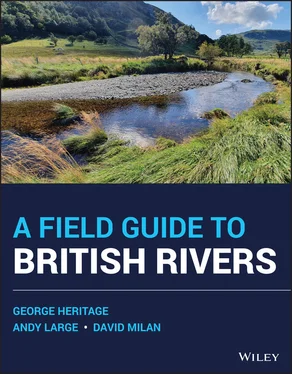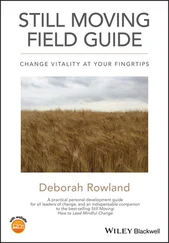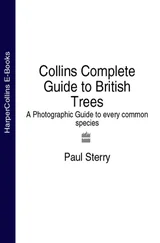| Channel type |
Description |
| Bedrock channels |
Most found in upland areas, though bedrock lined reaches can occur in certain lowland environments. They generally have little if any bed sediment and have limited hydraulic connection with the riparian zone. Channel gradients tend to be high, resulting in a high transport capacity but limited sediment supply. These factors, together with the high degree of bank strength, result in quite stable channels. |
| Cascades |
Restricted to upland areas with steep slopes and are characterised by disorganised bed material typically consisting of cobbles and boulders constrained by confining valley walls. The riparian zone is usually extremely small in extent and interactions with the channel are limited. The large size of bed and bank material, together with high levels of energy dissipation due to the bed roughness, dictates that the largest bed load only becomes mobile in extreme floods ( circa > 25‐year return interval). Bedrock outcrops are common and small pools may be present among the boulders. |
| Step‐pool channels |
Have a steep gradient and consists of large boulder splays which form discrete sediment accumulations across the channel, forming a series of “steps” which are separated by intervening pools containing finer sediment (typical spacing 1–4 channel widths). The stepped channel morphology results in zones of turbulence interspersed by more tranquil flows. As with cascade reaches, the high degree of channel roughness and large sediment on the channel bed and banks results in stable channels that respond only in very large flood events. The stream is generally confined by the valley sides, and there is limited development of terraces or floodplains. |
| Plane bed channels |
Generally moderate gradient streams with relatively featureless gravel/cobble beds, but which include units ranging from glides, riffles, and rapids. Sediment size and channel gradients are smaller than step‐pool channels and deeper pool sections tend to be lacking. The riverbed is generally armoured and, thus mobilized only in larger floods. Although channels are typically stable, they are more prone to channel change than any of the preceding channel types. With relatively more frequent bedload movement, they represent transitional channels between the more stable types listed above and the following more dynamic types of channel. Channels are generally straight and may be confined or unconfined by the valley sides. However, the banks – which generally comprise material resistant to lateral migration – constrain the channel from migrating laterally and developing alternate bars or riffles. |
| Pool‐riffle and Plane‐riffle channels |
Meandering and unconfined channel that during low flows are characterised by lateral oscillating sequences of bars, pools, and rifles, resulting from oscillations in hydraulic conditions from convergent (erosive) to divergent (depositional) flow environments (typical spacing 5–15 channel widths). The gradient of such channels is low to moderate, and the width to depth ratio high. The bed is predominantly gravel with occasional patches of cobbles and sand. Accumulation of sediments in gravel bars indicates increasingly transport‐limited conditions, though most large floods will produce some bedload movement on an annual basis, thus reducing the stability of the channel. In such channels, interactions between the stream and the riparian zone become more obvious with extensive over‐bank flood flows and wetland areas often characterising the riparian zone. The banks are typically resistant to erosion, and lateral migration of the channel is limited, resulting in relatively narrow and intermittently deep channels. Plane‐riffle channels form an intermediate channel type between those of plane‐bed and pool‐riffle channels. They retain many of the attributes of pool‐riffle channels; however, they generally have less defined pools, coarser (armoured) substrate, and less‐extensive bar features. They are a common channel form in the United Kingdom, although it is unclear whether their presence is natural or whether they represent a degraded form of the pool‐riffle channel. For management purposes, it is suggested that they are treated as a pool‐riffle channel type. |
| Braided channels |
Braided reaches can occur in a variety of settings. They are characterised by relatively high gradients (but ones that are less than upstream reaches) and/or abundant bedload. Sediment transport is usually limited under most conditions and the channel splits into several threads around instream bars. Nevertheless, poor bank strength renders them highly dynamic and channels will generally change even in relatively small flood events. |
| Wandering channel |
These reaches exhibit characteristics of braided and meandering channels and typically switch between divided and undivided channel types. Wandering channels may also be susceptible to channel avulsions during high‐flow events, where the channel switches to a historical planform. Wandering channels typically occur where a reduction of bed material size and channel slope is combined with a widening of the valley floor. In sediment transport terms such reaches are bedload channels, but the number of competent transport events in any year will vary greatly according to bed material size and the associated entrainment function. Generally, they can be viewed as a transition channel type between braided and lowland meandering channels. |
| Low‐gradient actively meandering |
Unconfined low‐gradient meandering channels with a bedload dominated by sand and fine gravel; hence, the channel bed has marked fine sediment accumulations that are mobile in most flood events. These occur in higher‐order (i.e. typically lowland) channels exhibiting more laminar flow hydraulics, with turbulent flows being uncommon. The fine bed sediment, erodible banks, and unconfined settings means that such channels are dynamic and prone to change. They also often have extensive riparian zones and floodplains which are linked to the channel. Bars and pools may be present and are associated with bends and crossing of the meander pattern. |
| Groundwater‐dominated channels |
Groundwater‐dominated rivers have low‐gradient channels and are characterised by a stable flow regime, although limestone rivers with cave systems may display hydrological characteristics like freshet rivers. This stable regime is a product of the permeable catchment geology and consequent reduction in overland flow that characterises groundwater‐dominated streams. Bed movement is infrequent, and sediments are predominantly transported in suspension. Typically, sediments are derived from catchment sources, although large macrophyte beds provide a source of in‐stream organic detritus. As bed disturbance is infrequent, deposited sediments may remain in the gravel for extended periods, promoting the accumulation of large quantities of fine sediment. Substrate generally comprises gravels, pebbles and sands, and glides and runs are the dominant flow types. Localised areas of riffle habitat may be present particularly where woody debris is available. |
| Low‐gradient passively meandering |
These channels are typically found at lower extremities of the channel system. Generally, they flow through high‐resistant materials, for instance clays and coarse deposits. They are generally sinuous; however, as the banks comprise materials that are resistant to erosion, they typically display “fixed” planform geometry. Thus, these channels are often incised and display low width to depth ratios. The beds typically comprise fine sedimentary materials (sands and silts), although pockets of gravel can be present, particularly in poorly formed bar deposits. These channels are typically deep, and flows are dominated by glides, although runs may be associated with meander bends. Riparian vegetation is influenced by the clay soils and is often sparser than in other channel types, comprising grasses shrubbery and smaller pockets of woody growth. Primary production is strong in these channels and coupled with stable beds and extensive growth of macrophyte vegetation. |












